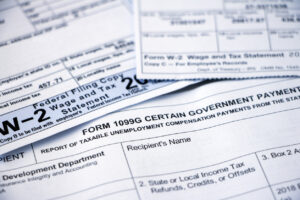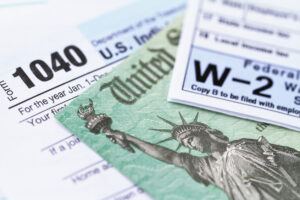IRS Forms 1099 match income and Social Security numbers.[1] Most people pay attention to these forms at tax time, but lawyers and clients alike should pay attention to them the rest of the year as well. Failing to report a Form 1099 is guaranteed to give you an IRS tax notice to pay up. These little forms are a major source of information for the IRS. Copies go to state tax authorities, which are useful in collecting state tax revenues.
Lawyers receive and send more Forms 1099 than most people, in part due to tax laws that single them out. Lawyers make good audit subjects because they often handle client funds. They also tend to have significant income. The IRS has a keen interest in the tax treatment of litigation settlements, judgments, and attorney’s fees. Lawyers are singled out for extra Forms 1099. The tax code requires companies making payments to attorneys to report the payments to the IRS on a Form 1099.
Each person engaged in business and making a payment of $600 or more for services must report it on a Form 1099. The rule is cumulative, so whereas one payment of $500 would not trigger the rule, two payments of $500 to a single payee during the year require a Form 1099 for the full $1,000. Lawyers must issue Forms 1099 to expert witnesses, jury consultants, investigators, and even co-counsel where services are performed and the payment is $600 or more.
A notable exception from the normal $600 rule is payments to corporations. Payments made to a corporation for services are generally exempt; however, an exception applies to payments for legal services. Put another way, the rule that payments to lawyers must be the subject of a Form 1099 trumps the rule that payments to corporation need not be. Thus, any payment for services of $600 or more to a lawyer or law firm must be the subject of a Form 1099, and it does not matter if the law firm is a corporation, LLC, LLP, or general partnership, nor does it matter how large or small the law firm may be. A lawyer or law firm paying fees to co-counsel or a referral fee to a lawyer must issue a Form 1099 regardless of how the lawyer or law firm is organized. Plus, any client paying a law firm more than $600 in a year as part of the client’s business must issue a Form 1099. Forms 1099 are generally issued in January of the year after payment. In general, they must be dispatched to the taxpayer and IRS by the last day of January.
Issuing Forms 1099 to Clients
One confusing tax reporting issue for law firms is whether to issue Forms 1099 to clients. Practice varies considerably, and many firms issue the forms routinely; however, most payments to clients do not actually require the forms. Of course, many lawyers receive funds that they pass along to their clients. That means law firms often cut checks to clients for a share of settlement proceeds. Even so, there is rarely a Form 1099 obligation for such payments. Most lawyers receiving a joint settlement check to resolve a client lawsuit are not considered payors. In fact, the settling defendant is considered the payor, not the law firm. Thus, the defendant generally has the obligation to issue the Forms 1099, not the lawyer.
Example 1: Larry Lawyer earns a contingent fee by helping Cathy Client sue her bank. The settlement check is payable jointly to Larry and Cathy. If the bank doesn’t know the Larry/Cathy split, it must issue two Forms 1099 to both Larry and Cathy, each for the full amount. When Larry cuts Cathy a check for her share, he need not issue a form.
Example 2: Consider the same facts as in Example 1, but assume that Larry tells the bank to issue two checks, one to Larry for 40 percent, and the other to Cathy for 60 percent. Here again, Larry has no obligation to issue a form because Cathy is getting paid by the bank. The bank will issue Larry a Form 1099 for his 40 percent. It will issue Cathy a Form 1099 for 100 percent, including the payment to Larry, even though the bank paid Larry directly. Cathy must find a way to deduct the legal fee.
Physical Injury Payments
One important exception to the rules for Forms 1099 applies to payments for personal physical injuries or physical sickness. Think legal settlements for auto accidents and slip-and-fall injuries. Given that such payments for compensatory damages are generally tax-free to the injured person, no Form 1099 is required.
Example 1: Hal Hurt is in a car crash and receives a $1 million settlement. Defendant Motors issues a joint check to Hal and his lawyer Sue Suits. Defendant is not required to issue a Form 1099 to Hal. Defendant must still issue a Form 1099 to Sue for the full $1 million.
Example 2: Same facts, but assume Sue asks for a $600,000 check issued to Hal (without a Form 1099) and a $400,000 check issued to her (with a Form 1099 to Sue for $400,000). Defendant Motors can agree to this request.
Other Payments to Clients
What about a law firm’s refund of legal fees to clients? Must those payments be reported to the client on Form 1099 issued to the client? If the refund is of monies held in the lawyer’s trust account, no Form 1099 is required; however, if the law firm was previously paid and is refunding an amount from the law firm’s own income, a Form 1099 is needed.
Example: Big Law LLP represents Joe Inventor and is holding $50,000 of Joe’s funds in its trust account. Due to a dispute over the quality of Big Law’s services, it agrees to refund $30,000 of Joe’s deposit. No Form 1099 is required because this was Joe’s money. Big Law also agrees to refund $60,000 of the monies Joe paid for fees over the last three years. Big Law is required to issue a Form 1099 for the $60,000 payment.
The primary area where a lawyer must issue a Form 1099 to a client is where the lawyer performs significant oversight and management functions. The tax regulations are not terribly clear exactly what these management and oversight functions are in many cases, but merely being a plaintiff’s lawyer and handling the settlement monies is not enough.
What if the lawyer is beyond merely receiving the money and dividing the lawyer’s and client’s shares? Under IRS regulations, if lawyers take on too big a role and exercise management and oversight of client monies, they become “payors” and as such are required to issue Forms 1099 when they disburse funds.
Joint Checks
IRS regulations contain extensive provisions governing joint checks and how Form 1099 should be issued in such cases. Most of these rules mean that lawyers will be receiving Forms 1099 when their names are on the settlement checks.
Example 1: Dastardly Defendant settles a case and issues a joint check to Clyde Client and Alice Attorney. Dastardly normally must issue one Form 1099 to Clyde for the full amount and one Form 1099 to Alice also for the full amount. This reality may cause Alice to prefer separate checks, one for the client funds, and one to pay the lawyer directly. That way, Alice may only receive a Form 1099 for her fees, not also for her client’s money.
Example 2: This time Dastardly Defendant issues a check for 60 percent of the settlement to Clyde Client and 40 percent to Alice Attorney. Dastardly issues one Form 1099 to Clyde for 100 percent, and one Form 1099 to Alice for 40 percent. So that Clyde doesn’t pay taxes on the fees paid to Alice for which he received a Form 1099, he will try to deduct the 40 percent on his tax return. Beginning in 2018, though, deductions for legal fees are now much more restricted than in the past. There is still an above-the-line deduction for legal fees in employment, civil rights, and whistleblower cases, but beyond that, many legal fees can no longer be deducted.
Seeking to help their clients avoid receiving Forms 1099, some plaintiff lawyers ask the defendant for one check payable to the “Jones Law Firm Trust Account.” Many defendants are willing to issue a single Form 1099 only to the Jones Law Firm in this situation. Technically, however, Treasury Regulations dictate that you should treat this Jones Law Firm Trust Account check just like a joint check payable to lawyer and client. That means two Forms 1099, each in the full amount, are required.
Judgment Calls and Penalties
Requirements to issue Forms 1099 have existed in the tax code and parallel state law for decades. Still, these requirements have become more rigorous in recent years. Penalty enforcement has also become tougher. More and more reporting is now required, and lawyers and law firms face not only the basic rules, but the special rules targeting legal fees.
Lawyers are not always required to issue Forms 1099, especially to clients. Nevertheless, the IRS is unlikely to criticize anyone for issuing more of the ubiquitous little forms. In fact, in the IRS’s view, the more Forms 1099 the better. Perhaps for that reason, it is becoming common for law firms to issue Forms 1099 to clients even where they are not strictly necessary. Defendants usually have this knee-jerk reaction as well—when in doubt issue the forms. Sometimes, though, both lawyers and defendants go overboard and issue the forms when they really should not.
Most penalties for nonintentional failures to file are modest—as small as $270 per form. This penalty for failure to file Forms 1099 is aimed primarily at large-scale failures, such as where a bank fails to issue thousands of the forms to account holders; however, law firms should be careful about these rules, too.
The distribution of the proceeds of a class action, for example, can trigger large-scale issuances of Forms 1099. In addition to the $270-per-failure penalty, the IRS also may try to deny a deduction for the item that should have been reported on a Form 1099. That means if you fail to issue a form for a $100,000 consulting fee, the IRS could claim it is nondeductible. It is usually possible to defeat this kind of draconian penalty, but the severity of the threat still makes it a potent one.
An often-cited technical danger (but generally not a serious risk) is the penalty for intentional violations. A taxpayer who knows that a Form 1099 is required to be issued and nevertheless ignores that obligation is asking for trouble. The IRS can impose a penalty equal to 10 percent of the amount of the payment.
Example: Larry Lawyer makes a $400,000 payment to co-counsel, but Larry fails to issue a required Form 1099 even though his CPA told him he was required to. In addition to other remedies, the IRS may impose a $40,000 penalty.
Although a 10-percent penalty is high, I have never personally seen this penalty imposed. In fact, I wonder how likely it is even to be proposed, unless the taxpayer has a damning memo in his file that he hands the IRS, making clear that he knew of the Form 1099 obligation and ignored it.
IRS Form W-9
Given that Forms 1099 require taxpayer identification numbers, attorneys are commonly asked to supply payors with their own taxpayer identification numbers and those of their clients. Usually such requests come on IRS Form W-9. If an attorney is requested to provide a taxpayer identification number and fails to provide it to a paying party, he or she is subject to a $50 penalty for each failure to supply that information.
The payments to be made to the attorney also may be subject to back-up withholding. As a practical matter, some defendants may refuse to pay over money without the required taxpayer identification numbers, or will seek to pay the money through a court. It is usually not worth fighting over Forms W-9. If you have negotiated for language in the settlement agreement making clear what Forms 1099 will (or will not) be issued, there should usually be no reason to fight over providing Forms W-9.
Conclusion
Receiving Forms 1099 is not particularly fun, but at least it is a reminder to report the payment on your tax return. Even many issuers of Forms 1099 may not especially like the form. Lawyers must pay special attention to these rules, and not just when they are settling cases or closing real estate deals. More than many other businesses and professionals, lawyers are commonly sending and receiving Forms 1099. Clients care a great deal about these rules as well, especially if they receive a big, fat Form 1099 in the mail that they were not expecting.
[1] Robert W. Wood is a tax lawyer with www.WoodLLP.com and the author of numerous tax books including Taxation of Damage Awards & Settlement Payments (www.TaxInstitute.com). This discussion is not intended as legal advice.

















